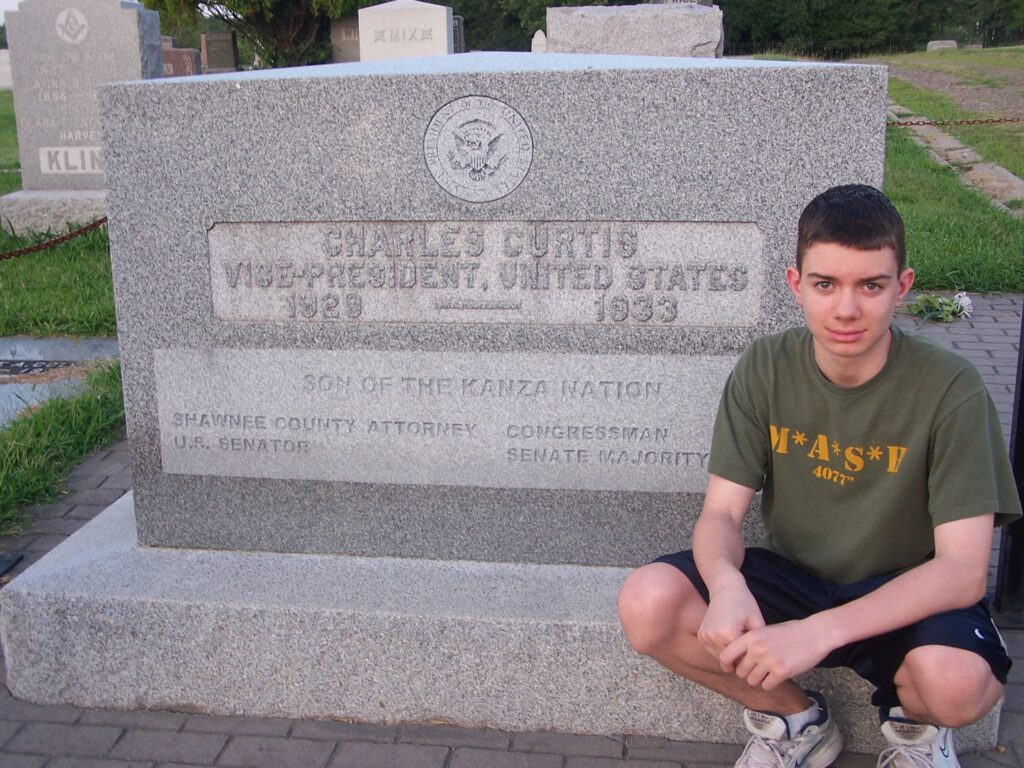| Interment Location | Visited | Sequence in Graves I Have Visited |
|---|---|---|
| Topeka, KS | August 11, 2009 | 2nd President Pro Tempore visited; 1st Senate Leader visited; 15th Vice President visited |
Charles Curtis is recognized as the first person of non-European lineage to serve as U.S. vice president. Curtis, who had 3/8 Native American ancestry, grew up on a reservation in Indian Territory before he became an influential figure in American politics. Curtis served as the Republican Party’s whip in the Senate and then as its majority leader prior to his election as vice president in 1928. Curtis’ time as VP was dominated by the Great Depression, which lasted past the end of his term in 1933 and even beyond his death three years later.
The monument in the Curtis plot describes the VP as a “son of the Kanza Nation.” Though Curtis was proud and open about his ancestry during his political career, his record on native issues was deleterious toward Indigenous Peoples. The 1898 Curtis Act — which he introduced as a member of the House — served to strip tribes in present-day Oklahoma of lands, break up their governments and courts, and give a federal commission the authority to determine tribal membership. The legislation was significantly changed from Curtis’ original draft before it became law, however, and Curtis was displeased with its final form. Yet he did support Indigenous populations assimilating with white American standards, which was a form of racism. In contrast, some of his other policy views — such as support of child labor laws and women’s rights — are still regarded favorably by wide swaths of Americans today.
Fast Facts
Born: January 25, 1860 in North Topeka, Kansas Territory
Spouse: Annie Baird Curtis (m. 1886-1924)
Political Affiliation: Republican Party
Senatorial Tenure: 1907-1913; 1915-1929
President Pro Tempore Tenure: 1911
Senate Republican Conference Leader Tenure: 1924-1929
Vice Presidential Term: 1929-1933 under Herbert Hoover
Died: February 8, 1936 in Washington, D.C.
Cause of Death: Heart Attack
Age: 76
Interment: Topeka Cemetery, Topeka, Kansas
"The mere right to vote, not exercised, is useless."
- Charles Curtis
August 18, 1928 in his speech accepting the Republican Party nomination for vice president, delivered in Topeka, Kansas
Sources Consulted and Further Reading
@kdgravehunter. “Charles Curtis, the first BIPOC veep.” Instagram, February 8, 2021. Accessed January 30, 2022. https://www.instagram.com/p/CLCn62wAb8t/.
Commercial and Financial Chronicle. “Senator Curtis in Accepting Nomination for Vice-President on Republican Ticket Declares Opposition to Repeal of Eighteenth Amendment—Proposes Committee to Solve Farm Relief Problem.” August 25, 1928. From FRASER. https://fraser.stlouisfed.org/title/commercial-financial-chronicle-1339/august-25-1928-517023.
Estes, Roberta. “The Curtis Act of 1898.” Native Heritage Project (blog). August 17, 2013. https://nativeheritageproject.com/2013/08/17/the-curtis-act-of-1898/.




